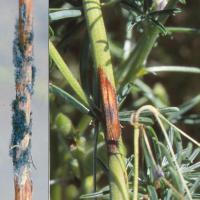Diagnosing grey mould in narrow-leafed lupins
Grey mould (Botrytis cinerea) is a rare fungal disease that is favoured by warm humid spring conditions or dense crop canopies.
What to look for
- Lesions on flowers and pods in humid spring conditions that cause them to abort.
- Large sunken lesions that girdle and kill branches.
- Mature lesions are characterised by grey fuzzy mould that may contain large black sclerotia.
Plant
What else could it be
| Condition | Similarities | Differences |
|---|---|---|
| Diagnosing brown spot in narrow-leafed lupins | Dark stem lesions | Surface lesions without grey fuzzy mould |
| Diagnosing sclerotinia collar rot in narrow-leafed lupins | Stem lesions, premature death. | White cottony growth on stem instead of grey fuzzy growth. |
Where did it come from?

Wet or humid conditions
- The fungus is hosted by many broadfleaf plants, and survives on infected stubble.
- Warm moist conditions favour infection, which ceases in dry spring weather.
- Millions of spores are produced in grey mould that can be wind-borne over large distances
Management strategies
- This disease may be more common in albus lupins but rarely causes economic damage in WA lupin crops.
See also
Where to go for expert help
Page last updated: Friday, 17 April 2015 - 9:09am


